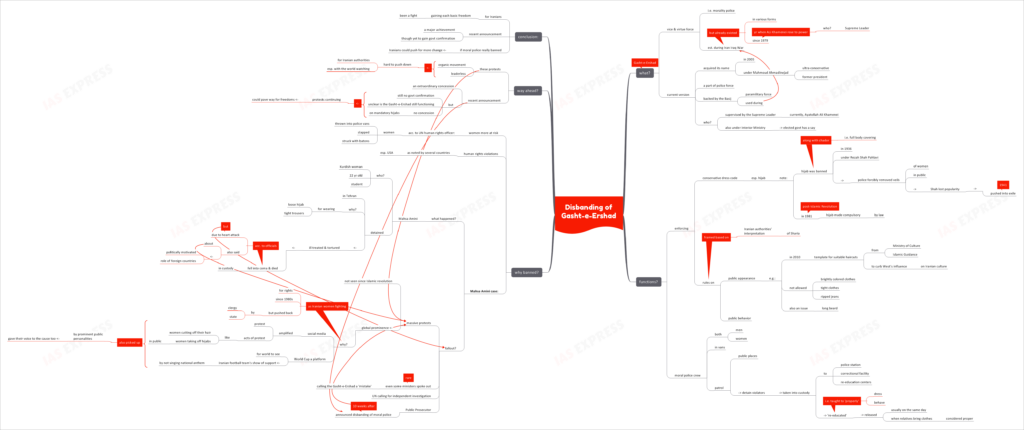Disbanding Gasht-e-Ershad- Did the Protests Help?

Recently, Iran’s Public Prosecutor announced that the country’s dreaded Gasht-e-Ershad, an entity at the center of the major protests over the Mahsa Amini case, has been scrapped. However, this hasn’t been confirmed by the government yet.

This topic of “Disbanding Gasht-e-Ershad- Did the Protests Help?” is important from the perspective of the UPSC IAS Examination, which falls under General Studies Portion.
What is the Gasht-e-Ershad?
- The Gasht-e-Ershad is a morality police or ‘vice and virtue force’, that was established during the Iran-Iraq War. However, the country has had moral police in various forms since 1979- the year when Supreme Leader Ali Khamenei rose to power.
- The current version acquired its name under Mahmoud Ahmadinejad, the ultra-conservative former president in 2005.
- The Gasht-e-Ershad is a part of the police force and is backed by the Basij, a paramilitary force that was used during the Iran-Iraq War.
- It is supervised by the Supreme Leader (currently, Ayatollah Ali Khamenei). However, the elected government, through the Interior Ministry, too has a say in the moral police’s activities.
What are its functions?
- The Gasht-e-Ershad is tasked with enforcing the country’s conservative dress code, the most notable of which is the hijab for women.
- Interestingly, in 1936, under the rule of Reza Shah Pahlavi, a ban was imposed on the hijab and the whole body-covering chador.
- This ban was strictly implemented, with police personnel even forcibly removing the veils of those violating the rule in public.
- This was one of the key reasons why Shah became unpopular and eventually pushed into exile in 1941.
- In 1981 (post-Islamic Revolution), a law was enacted to make hijab mandatory.
- Interestingly, in 1936, under the rule of Reza Shah Pahlavi, a ban was imposed on the hijab and the whole body-covering chador.
- Apart from this, the moral police is also responsible for ensuring conformance with other rules on public appearance and conduct, framed according to the Iranian authorities’ interpretation of the Sharia.
- For instance, in 2010, the Ministry of Culture and Islamic Guidance released a template for ‘suitable haircuts’. This was to curb Western influence on Iranian culture. The morality police enforced this at salons.
- Brightly coloured clothing, ripped jeans and tight clothes are also banned.
- Long beards are also an issue.
- In order to enforce compliance, the moral police’s crew (with both men and women officers) often patrol public places in vans.
- They detain those violating the code and taken to the police station/ correctional facility/ re-education centre where they are taught how to dress/ behave ‘properly’.
- Generally, the detainees are released on the same day after a relative brings them clothes considered ‘proper’.
Why was it banned?
- Women are more at risk of being detained and subject to ‘re-education’. A UN human rights officer noted that women have been thrown into police vans, slapped and struck with batons for not conforming to the code.
- Countries, especially the USA, have been commenting on the human rights violations by the moral police and considering sanctions.
Mahsa Amini case:
- A 22-year old Kurdish student, Mahsa Amini, was detained in Tehran for wearing loose hijab and tight trousers.
- She is alleged to have been ill-treated and tortured, before she fell into a coma and died in custody.
- While the Gasht-e-Ershad maintain that the death was due to a heart attack, the incident triggered widespread protests at a level not seen since the Islamic Revolution.
- In a rare instance, even some Iranian ministers started speaking out against the Gasht-e-Ershad, calling it a ‘mistake’.
- While the Islamic Republic has tried to wave off the incident as ‘politically motivated’ and the protests as having been stoked by foreign nations, the issue gained global prominence.
- The UN stepped up to call for an independent investigation into the student’s death.
- After some 10 weeks of relentless agitations, the Public Prosecutor made the recent announcement to ban the dreaded police.
Why did the protest gain so much prominence?
Iranian women have been fighting for their rights since 1980s and the state and clergy have pushed back each time. The story was different this time due to a number of reasons:
- Social media helped amplify the protests. Several acts of protest started trending worldwide:
- Women cut off their hair
- Women discarded their hijabs in public, etc.
- The World Cup too offered a platform for the world to see. The Iranian football team showed their solidarity with the protest’s cause by not singing the national anthem.
- This was picked up by prominent public personalities across the world too, adding their voice to the protests.
What is the way ahead?
- The protests against the moral police has evolved as a leaderless, organic movement- making it difficult for the Iranian authorities to launch a full crackdown, especially given that the whole world is watching.
- The recent announcement marks an extraordinary concession from the conservative regime. However, the ban is yet to be confirmed by the Interior Ministry and it is unclear if the moral police has actually stopped functioning.
- Also, the regime hasn’t made any concession on the issue of mandatory headscarves.
- Meanwhile, the protestors haven’t called off their agitation, demanding solid action against such human rights abuses. It is expected that the courage of the protestors would pave the way for more freedoms.
Conclusion:
For the Iranian people, gaining each basic freedom has been a fight. The recent announcement to ban the Gasht e Ershad is in itself a major achievement, though it is yet to gain government confirmation. If the dreaded moral police is truly on its way out, then Iranians could push for more change.
Practice Question for Mains:
Discuss the significance of Iran announcing a ban on the Gasht-e-Ershad. Does this signal a major reform in the country? (250 words)

